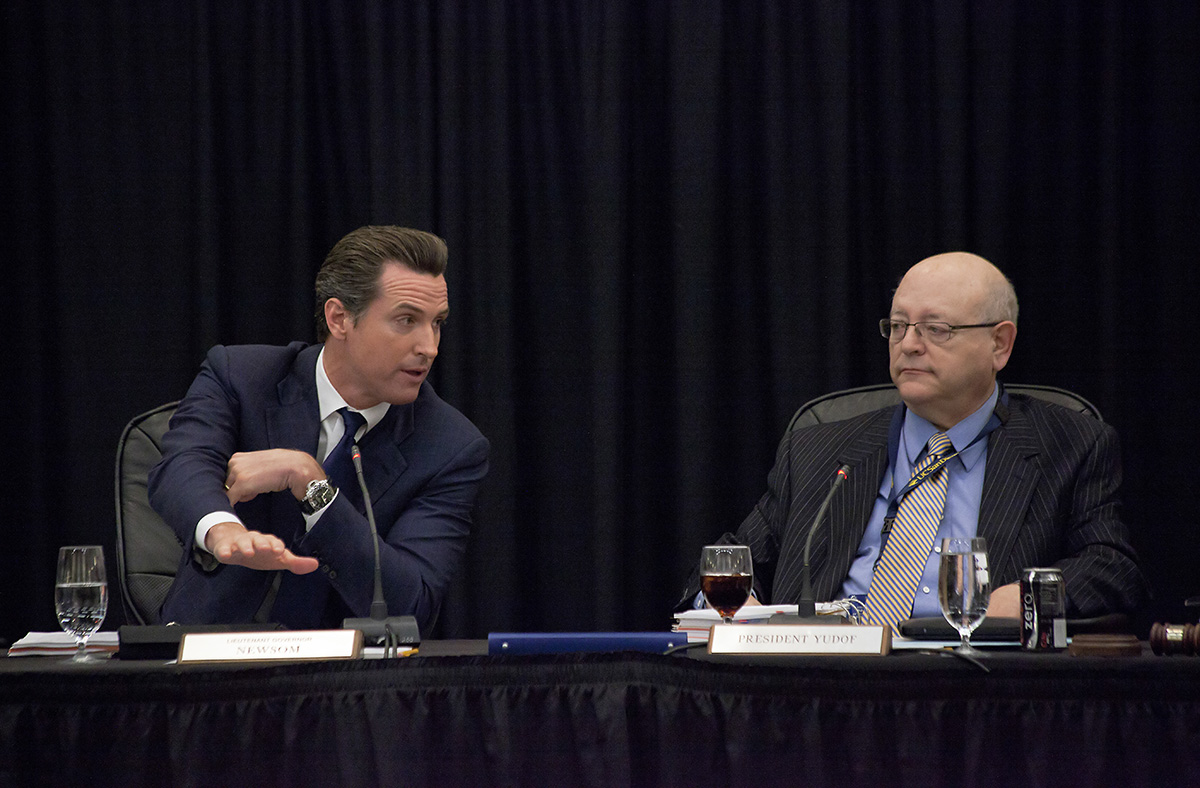Gov. Newsom proposes largest investment in UC history despite budget cuts in 2020

Gov. Gavin Newsom proposed revisions to the California budget that would allocate more than $807 million to the University of California. (Daily Bruin file photo)
By Lindsay Turpin
June 1, 2021 12:00 p.m.
UCLA professors expressed relief after California Gov. Gavin Newsom proposed the largest state investment in the history of the University of California after stark budget cuts made in 2020 due to the COVID-19 pandemic.
Newsom proposed several revisions to the California budget, allocating more than $807 million to the UC. The increase in funding attempts to restore the losses from cuts of more than $300 million in 2020.
The investment included ongoing funds such as support operational needs, base growth and medical education funding as well as one-time investments in organizations such as the UCLA Labor Center and the UCLA Asian American Studies Center, according to the May revision budget proposal.
Newsom originally cut UC’s budget in 2020 because state revenue was expected to decrease dramatically during the pandemic, said Daniel Mitchell, professor emeritus at UCLA Anderson Graduate School of Management and UCLA Luskin School of Public Affairs.
Newsom’s office released a statement May 2020 announcing budget cuts due to the economic crisis caused by COVID-19, but pledged to still prioritize public education and accommodations for remote learning.
However, the stock market was not as badly impacted as expected in 2020, and the state income tax collected plenty of revenue that could be used to fund the UC, Mitchell said.
“So now the governor in effect is sort of refunding us and giving us more money than we had two years ago in our allocation and certainly more money than we had a year ago,” Mitchell said.
The University of California Office of the President released a statement May 14 expressing gratitude for the increase in funding. The statement said the investment is the largest the state has ever given to the UC, and is $932.8 million more than the 2019 allocations.
The varying investment amounts the state gives UC each year often dictate what the University is able to accomplish, Mitchell said.
It’s difficult to tell whether this investment is a one-time occurrence due to the $75.7 billion California budget surplus or if it will become standard practice, said Ozan Jaquette, an assistant professor at UCLA Graduate School of Education and Information Studies.
UCLA recently announced a 3% increase of the base salary for faculty and staff, Jaquette added. This could be a hint that the financial situation is secure and large investments such as this will be ongoing, he said.
Gary Orfield, professor of education, law, political science and urban planning said the governor’s one-time funds for the UCLA Labor Center and Asian American Studies Program show the current relevance of those areas and UCLA’s leadership in issues like anti-Asian discrimination, Orfield added.
UC Programs in Medical Education will also receive ongoing investment from the state, according to the UCOP statement. The program aims to increase medical access in underserved regions and communities by encouraging medical degrees and providing mentorships, the statement said.
“The recognition of medical education through UC PRIME will be an investment that helps communities already suffering from a lack of access to health care professionals, which is a problem that is expected to worsen in coming years,” said UCOP spokesperson Heather Harper in an emailed statement.
Although the state has encouraged the UC to continue to grow some of its most successful programs with this investment, some disagreements between the government and universities remain about designing the future of the UC through the budget, Mitchell said
He said although the constitution gives the UC Board of Regents power to design the budget details, the legislature often takes more power without resistance because it gives concessions to the UC by funding specific areas such as the UCLA Labor Center.
The state senate recently proposed a shift toward cutting out-of-state enrollment for undergraduate programs in the UC, according to the Los Angeles Times.
Out-of-state UC students pay higher tuition, so cutting their enrollment would cut the University’s budget, Mitchell said. He added that efforts toward admitting more California residents would decrease diversity within universities.
California policymakers envision the UC’s future to include better facilities, more affordable housing, larger enrollment and an orientation toward enrolling Californians, Jaquette said.
“It’s like all toward this bigger push … by policymakers wanting the UC to be more accessible to more California residents,” Jaquette said.
Policymakers also want to enroll more students in general to the UC system, Jaquette said. This means it is necessary to increase affordable housing opportunities and other facilities that would allow for a larger capacity of students, Jaquette said.
California universities will be given $4 billion in state grants within the next two years to increase affordable housing for students, the UCOP statement said.
However, investment promises cannot project too far in the future, Orfield said. The state depends on fluctuating factors for how much money is available to invest into initiatives such as the UC, he said.
“California depends a lot on the business cycle, especially the business cycle and the stock market, which has made this such a glorious year for the state budget,” Orfield said. “We don’t know the future.”

